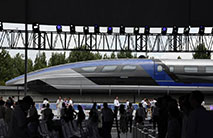Providing water for China's space station astronauts
BEIJING, July 23 (Xinhua) -- A video clip released recently by the China Manned Space Agency (CMSA) shows one of the three astronauts stationed on the country's space station core module Tianhe drinking water from a plastic bag in the morning.
Water is vital for life. In the waterless environment of space, a safe and reliable water supply is a vital necessity for astronauts staying in orbit for a long time.
As of Friday, the three Chinese astronauts sent up by the Shenzhou-12 spacecraft have remained in orbit for about 36 days, breaking the 33-day record set by the Shenzhou-11 crew in 2016.
MULTIPLE SOURCES
Water is made available for the astronauts on the space station in three ways: transport by spacecraft, on-site generation and recycling.
Before the astronauts are sent into space, a supply of water is delivered to the space station. For example, before the launch of Shenzhou-12, the Tianzhou-2 cargo craft sent supplies to the core module for the Shenzhou-12 crew.
According to the CMSA, 6.8 tonnes of supplies are delivered, including two space suits, 20 oxygen and nitrogen cylinders, food and clothing, experiment payloads, and more than 10 bags of water for daily use and electrolytic oxygen generation.
Water can also be generated onboard the space station by fuel cell, with hydrogen and oxygen being oxidized into water on two electrodes under the action of a catalyst. This process simultaneously provides electricity for the space station.
The water is cooled through a cooler, bringing its temperature down to 18 to 24 degrees Celsius, and purified by a silver ion sterilizer, before being sent to a storage tank.
RECYCLE AND REUSE
The three astronauts of the Shenzhou-12 crew will stay on the space station for three months, during which time a lot of water is consumed. The recycling and reuse of water can help to meet the demand.
In order to ensure its economical long-term operation, the space station uses the Environmental Control and Life Support System (ECLSS) to realize the recycling of supplies, and it plays an important role in water recycling.
The ECLSS can collect the water vapor exhaled by astronauts via a condensing and drying module. Treated by a purification device, the condensate is converted into recycled water for drinking.
Urine produced by astronauts can also be collected and treated into purified water.
"The recycling of water can reduce the load burden of cargo craft and greatly cut the operating cost of the space station," said Cui Guangzhi, a designer of the urine-treatment system, a sub-system of the ECLSS, with the Second Institute of the China Aerospace Science and Industry Corporation Limited (CASIC).
Data on human physiological activity shows that each astronaut generates about 2 kilograms of urine and flushing water per day in orbit, while exhaling about 1.8 kilograms of water vapor into the cabin over the same time period.
The ECLSS can collect the urine from astronauts and the water condensate in the cabin, and then treat it into purified water, providing an important source of drinking water in orbit. As long as the system runs properly, astronauts can consume a very small amount of water in one day.
SUFFICIENT, SAFE AND RELIABLE
The supply of water on the space station has to be sufficient, reliable and safe.
Ensuring a sufficient supply is of crucial importance, with each astronaut generally requiring between 2.5 and 3 liters per day when in orbit. However, the overall supply on board varies depending on the duration of the mission and the number of crew members.
Meanwhile, the hardware of the drinking-water supply system must be suitable for the weightless environment, ensuring that astronauts can reliably produce safe drinking water and conveniently prepare rehydratable food and beverages.
The silver ion disinfectant system employed by the ECLSS sterilizes the water, ensuring that it is safe to drink. Low concentrations of silver ions, less than 0.5 milligrams per liter, have been proved to kill bacteria in water while keeping it drinkable.
China sent the space station's core module Tianhe into space on April 29, kicking off a series of key launch missions that aims to complete the construction of the station by the end of next year.
On May 29, China launched the cargo craft Tianzhou-2, which docked with Tianhe on May 30, delivering supplies, equipment and propellant.
On June 17, China launched the crewed spacecraft Shenzhou-12, sending three astronauts to Tianhe for a three-month mission.
Photos
Related Stories
- How Chinese astronauts maintain personal hygiene in space
- Model of China's space station core module Tianhe in Shanghai Astronomy Museum
- Homemade spacesuits ensure safety of Chinese astronauts in space
- China’s space station recycles 66 liters of urine in 3 weeks to support crew
- Shenzhou-12 astronauts work out in spacecraft
Copyright © 2021 People's Daily Online. All Rights Reserved.










